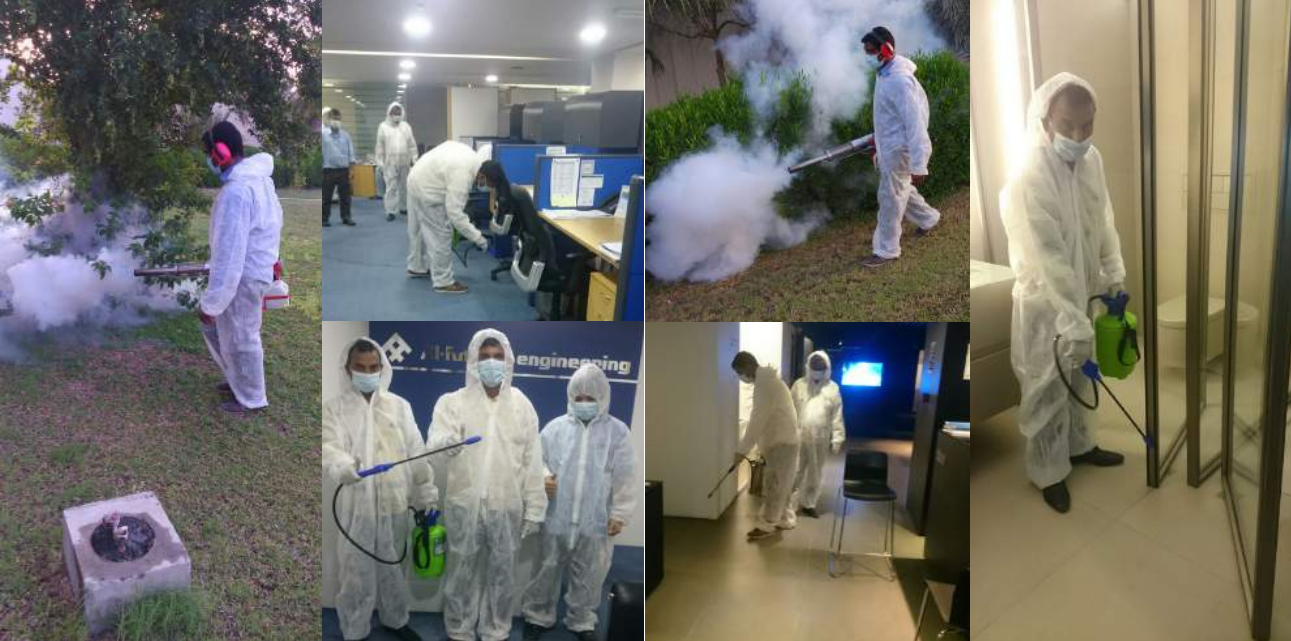
AL BUHAIRA# cleaning, disinfection, pest control, and reptile control refer to a set of efforts and operations carried out to maintain public health and ensure a clean environment free from harmful organisms. This activity includes several tasks, such as:
1. Cleaning and disinfection: This involves using specific methods to eliminate germs and microorganisms present in different spaces and surfaces to prevent the spread of diseases. Special cleaners and disinfectants containing strong chemicals are used to kill bacteria, viruses, and fungi.
2. Pest control: Measures are implemented to get rid of harmful insects such as mosquitoes, flies, cockroaches, ants, rats, and other pests. These measures include the use of insecticides, traps, and other methods to control the reproduction and spread of pests.
3. Rodent control: Steps are taken to control rodents such as mice and rats, as they pose a threat to public health and can cause contamination and disease transmission. These measures include the use of baits, traps, and other methods to eliminate rodents and prevent their entry into buildings.
4. Reptile control: This process involves getting rid of harmful reptiles such as snakes, lizards, and scorpions. Suitable methods are used to control these organisms and avoid the risks associated with their presence.
The aim of these activities is to improve public health and provide a safe and clean environment for individuals and communities. ***** AL BUHAIRA /// Preventive measures are taken before, during, and after the process of disinfection, sanitization, pest control, and rodent control. Here are some common preventive measures that can be followed:
Before the process:
1. Planning and evaluation: The areas and locations that require disinfection, sanitization, or pest and rodent control need to be identified. The scale of the operation is assessed, and the necessary resources and equipment are determined.
2. Preparation and cleaning: This involves cleaning and preparing the areas to be disinfected, sanitized, or treated for pests and rodents. Debris and deposits should be removed, and surfaces should be cleaned using appropriate cleansers.
3. Securing protective equipment: Workers should use the necessary protective equipment before commencing the process. This includes wearing gloves, masks, goggles, and protective clothing.
During the process:
1. Practicing hygiene measures: Workers should follow personal hygiene and public health measures while carrying out the process of disinfection, sanitization, pest control, and rodent control. This includes regular handwashing, avoiding touching the face and eyes, and refraining from eating in the treated areas.
2. Using necessary chemicals: Technicians should follow proper instructions for using disinfectant chemicals or pesticides. Precautions should be taken to minimize potential exposure to chemicals.
After the process:
1. Ventilation: The disinfected or sanitized areas should be well-ventilated after the completion of the process. This helps to remove chemical odors and promote airflow.
2. Cleaning and organizing: Ensuring that the used equipment is properly cleaned and organized after the process is important. Waste and consumables should be disposed of safely and appropriately.
3. Evaluation and monitoring: The effectiveness of the process should be evaluated, and results should be monitored to ensure the desired outcomes are achieved. Corrective measures can be taken if necessary.
The specific preventive measures may vary depending on the type of process, location, and surrounding conditions. It is always recommended to follow local and national guidelines and instructions for best results and to ensure everyone's safety. ***** AL BUHAIRA ///// From that perspective, it is important to regularly change the disinfection, sanitization, and pesticide materials used to ensure safe and effective results. The exact frequency of changing these materials cannot be determined as it depends on several factors such as the type of material used, its exposure to contamination and deterioration. However, there are some general principles that can be followed:
1. Follow manufacturer's instructions: It is important to adhere to the guidelines and instructions provided by the manufacturer for disinfection, sanitization, and pesticide materials. These instructions include the specific materials used, proper concentration, application periods, and expiration dates.
2. Assess the effectiveness of the materials: The effectiveness of the materials used should be evaluated by monitoring the results of disinfection, sanitization, and pesticide spraying. If the results are not satisfactory or if noticeable improvements in the level of contamination, pests, or reptiles are observed, it may be necessary to change the materials being used.
3. Maintain monitoring and documentation schedules: It is recommended to create monitoring schedules that record the dates of material usage and changes, as well as application periods. These schedules can be used to ensure compliance with the recommended timeline and achieve effective and safe results.
By regularly changing the materials and maintaining consistent monitoring, the effectiveness of disinfection, sanitization, and pest control measures can be preserved, reducing potential risks to public health. It is always advised to consult and contact us at INFO@ALBUHARA.NET for specific guidance on the materials used and appropriate monitoring schedules for specific environments and conditions.